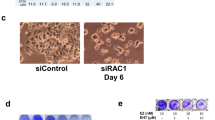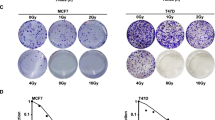Abstract
Loss of p53 function by mutational inactivation is the most common marker of the cancerous phenotype. Previous studies from our laboratory have demonstrated 17 β estradiol (E2) induction of p53 protein expression in breast cancer cells. Although direct effects of E2 on the expression of p53 gene are not known, the steroid is a potent regulator of c-Myc transcription. In the present studies, we have examined the ability of E2 and antiestrogens to regulate the P1 promoter of the p53 gene which contains a c-Myc responsive element. Estrogen receptor (ER)-positive T47D and MCF-7 cells were transiently transfected with the P1CAT reporter plasmid and levels of CAT activity in response to serum, E2 and antiestrogens were monitored. Factors in serum were noted to be the dominant inducers of chloramphenicol acetyltransferase (CAT) expression in MCF-7 cells. The levels of CAT were drastically reduced when cells were maintained in serum free medium (SFM). However, a subtle ER-mediated induction of CAT expression was detectable when MCF-7 cells, cultured in SFM, were treated with E2. In serum-stimulated T47D cells, the CAT expression was minimal. The full ER antagonist, ICI 182 780 (ICI) had no effect. Treatment with E2 or 4-hydroxy tamoxifen (OHT) resulted in P1CAT induction; OHT was more effective than E2. Consistent with c-Myc regulation of the P1 promoter, E2 stimulated endogenous c-Myc in both cell lines. Two forms of c-Myc were expressed independent of E2 stimuli. The expression of a third more rapidly migrating form was E2-dependent and ER-mediated since it was blocked by the full ER antagonist, ICI, but not by the ER agonist/antagonist OHT. These data demonstrate both ER-mediated and ER-independent regulation of c-Myc and the P1 promoter of the p53 gene, and show differential effects of the two classes of antiestrogens in their ability to induce the P1 promoter of the p53 gene in breast cancer cells.
This is a preview of subscription content, access via your institution
Access options
Subscribe to this journal
Receive 50 print issues and online access
$259.00 per year
only $5.18 per issue
Buy this article
- Purchase on Springer Link
- Instant access to full article PDF
Prices may be subject to local taxes which are calculated during checkout





Similar content being viewed by others
Abbreviations
- BCS:
-
bovine calf serum
- CAT:
-
chlomaphenicol acetyltransferase
- E2:
-
17-β estradiol
- ECL:
-
enhanced chemiluminescence
- ER:
-
estrogen receptor
- FBS:
-
fetal bovine serum
- ICI:
-
(ICI 182 780)
- OHT:
-
4-hydroxy tamoxifen
- PVDF:
-
polyvinylidene diflurode
- SFM:
-
serum free medium
References
Altucci L, Addeo R, Cicatiello L, Dauvois S, Parker MG, Truss M, Beato M, Sica V, Bresciani F and Weisz A. . 1996 Oncogene 12: 2315–2324.
Donehower LA and Bradley A. . 1993 Biochim. Biophys. Acta 1155: 181–205.
Deffie A, Wu H, Reinke V and Lozano G. . 1993 Mol. Cell. Biol. 13: 3415–3423.
Dubik D and Shiu RPC. . 1988 J. Biol. Chem. 263: 12705–12708.
Dulic V, Kaufmann WK, Wilson SJ, Tisty TD, Lees E, Harper JW, Elledge SJ and Reed SI. . 1994 Cell 76: 1013–1023.
Evan GI, Wyllie AH, Gilbert CS, Littlewood TD, Land H, Brooks M, Waters CM, Penn LZ and Hancock DC. . 1992 Cell 69: 119–128.
Foster JS and Wimalasena J. . 1996 Mol. Endocrinol. 10: 488–498.
Haas-Kogan DA, Kogan SC, Levi D, Dazin P, T'Ang A, Fung YKT and Israel MA. . 1995 EMBO J. 14: 461–472.
Hamel PA, Gill RM, Phillips RA and Gallie BL. . 1992 Mol. Cell. Biol. 12: 3431–3438.
Hermeking H and Eick D. . 1994 Science 265: 2091–2093.
Hurd C, Khattree N, Alban P, Nag K, Jhanwar SC, Dinda S and Moudgil VK. . 1995 J. Biol. Chem. 270: 28507–28510.
Hurd C, Khattree N, Dinda S, Alban P and Moudgil VK. . 1997 Oncogene 15: 991–995.
Hurd C and Moudgil VK. . (1998) In: Handbook of Physiology, Vol. 1: Cellular Endocrinology, (ed. Conn, PM.) Oxford University Press p. 383–411.
Kang Y, Cortina R and Perry RR. . 1996 J. Natl. Canc. Inst. 88: 279–284.
Kodali S, Burkley M, Nag K, Taylor C and Moudgil VK. . 1994 Biochem. Biophys. Res. Commun. 202: 1413–1419.
Lowe SW, Bodis S, McClatchey A, Remington L, Ruley HE, Fisher DE, Housman DE and Jacks T. . 1994 Science 266: 807–810.
Lowe SW, Ruley HE, Jacks T and Housman DE. . 1993 Cell 74: 957–967.
Lukas J, Bartkova J and Bartek J. . 1996 Mol. Cell. Biol. 16: 6917–6925.
McCormack SJ, Weaver Z, Deming S, Natarajan G, Torri J, Johnson MD, Liyanage M, Reid T and Dickson RB. . 1998 Oncogene 16: 2755–2766.
Planas-Silva MD and Weinberg RA. . 1997 Mol. Cell. Biol. 17: 4059–4069.
Prall OWJ, Sarcevic B, Musgrove EA, Watts CKW and Sutherland RL. . 1997 J. Biol. Chem. 272: 10882–10894.
Reisman D, Greenberg M and Rotter V. . 1988 Proc. Natl. Acad. Sci. USA 85: 5146–5150.
Roy B, Beamon J, Balint E and Reisman D. . 1994 Mol. Cell. Biol. 14: 7805–7815.
Rustgi AK, Dyson N and Bernards R. . 1991 Nature 352: 541–544.
Uittenbogaard MN, Giebler HA, Reisman D and Nyborg JK. . 1995 J. Biol. Chem. 270: 28503–28506.
Wu H and Lozano G. . 1994 J. Biol. Chem. 269: 20067–20074.
Acknowledgements
The authors are grateful to Dr David Reisman, University of South Carolina, for providing the P1CAT reporter plasmid. The advice and assistance from Drs Janice Schwartz (Wayne State University), Anne Hitt and Jill Zeilstra-Ryalls (Oakland University) are deeply appreciated. The studies were supported in part by the National Institutes of Health (DK 20893) and the Research Excellence Award by the Center for Biomedical Research, Oakland University.
Author information
Authors and Affiliations
Rights and permissions
About this article
Cite this article
Hurd, C., Dinda, S., Khattree, N. et al. Estrogen-dependent and independent activation of the P1 promoter of the p53 gene in transiently transfected breast cancer cells. Oncogene 18, 1067–1072 (1999). https://doi.org/10.1038/sj.onc.1202398
Received:
Revised:
Accepted:
Published:
Issue Date:
DOI: https://doi.org/10.1038/sj.onc.1202398
Keywords
This article is cited by
-
Estrogen receptor α dependent regulation of estrogen related receptor β and its role in cell cycle in breast cancer
BMC Cancer (2018)
-
TRIM25 has a dual function in the p53/Mdm2 circuit
Oncogene (2015)
-
Deconvoluting the Obesity and Breast Cancer Link: Secretome, Soil and Seed Interactions
Journal of Mammary Gland Biology and Neoplasia (2013)
-
Estrogen levels act as a rheostat on p53 levels and modulate p53-dependent responses in breast cancer cell lines
Breast Cancer Research and Treatment (2011)
-
P53 genotype as a determinant of ER expression and tamoxifen response in the MMTV-Wnt-1 model of mammary carcinogenesis
Breast Cancer Research and Treatment (2011)



